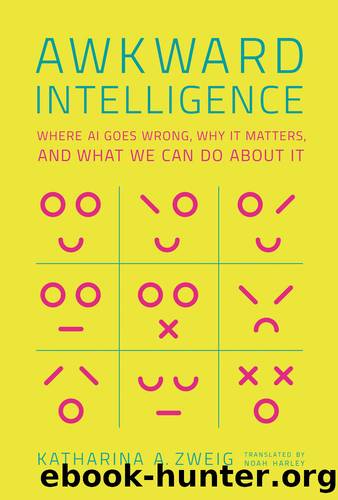Awkward Intelligence by Katharina A. Zweig

Author:Katharina A. Zweig [Zweig, Katharina]
Language: eng
Format: epub
Publisher: MIT Press
Figure 33
Between 2010 and 2017, the error rate for image recognition by AI fell from 28 percent to just over 2 percent (results from the ILSVRC, Classification and Localization Division; see https://image-net.org/challenges/LSVRC/index.php).
If your mind works anything like mine does, at this point you might ask whether this sort of approach doesnât make things pretty easy on the computer. If a computer thinks it detects (a) a sunset, (b) a face, (c) a toothbrush, (d) a fish, and (e) a television in an image, and one of them is correct, did it really win the contest? It wasnât all that simple for the machine, however. Many images contain more than one object, and it is often unclear which is supposed to be the main one; itâs not always in the middle or taking up the most space.
If youâd like to see the images for yourself, thereâs a list of the thousand categories that were supposed to be learned at http://image-net.org/challenges/LSVRC/2012/browse-synsets, all of which come from a larger data set called ImageNet. Each category in ImageNet contains a different number of images, some of which are ridiculously difficult. The category Dungeness Crab, for example, sets an image of a living specimen next to a beautifully arranged, neatly carved up crab where all thatâs missing is a squeeze of lemon. In another image, a fairly pale tourist stands half-naked on a beach holding up two discoveries that are only marginally visible.3
If you click through the images, youâll find that some have been horribly miscategorized. The category Foot Ruler, for exampleâa ruler that is a foot longâalso includes a series of images of feet with no ruler at all, but which are evidently a foot long. The folder also contains a tremendous number of images of fish laid out along a ruler, probably to measure them for a contest. The ruler itself is barely visible. In this case, you would be entirely justified in doubting whether this image was assigned the right central category, especially when anyone can see itâs a fishâpardon me, an American brown trout with an auditory canal on its left-hand side and a spotted tongue. As everyone knows.
Against this backdrop, all you can do is tip your cap to what machines have managed to accomplish with image recognition. When you consider that they are spotting objects that are themselves hidden and may not even play the leading role in an image, and whatâs more may contain highly specific categories like different dog breeds, itâs a wonder that machines now only classify 2.5 percent of images incorrectly. In 2010 it was still at 28 percent.
But wait a minuteâI still owe you a comparison to human labelers, donât I? Iâm sure youâre imagining that a small army of testers were recruited to solve the same task as the machines. For each image testers would select five potential matching categories, after first having learned the thousand categories possible by heart. But whoâs going to learn a thousand categories by heart? Good question! The
Download
This site does not store any files on its server. We only index and link to content provided by other sites. Please contact the content providers to delete copyright contents if any and email us, we'll remove relevant links or contents immediately.
Exploring Deepfakes by Bryan Lyon and Matt Tora(8345)
Robo-Advisor with Python by Aki Ranin(8291)
Offensive Shellcode from Scratch by Rishalin Pillay(6414)
Microsoft 365 and SharePoint Online Cookbook by Gaurav Mahajan Sudeep Ghatak Nate Chamberlain Scott Brewster(5667)
Ego Is the Enemy by Ryan Holiday(5344)
Management Strategies for the Cloud Revolution: How Cloud Computing Is Transforming Business and Why You Can't Afford to Be Left Behind by Charles Babcock(4546)
Python for ArcGIS Pro by Silas Toms Bill Parker(4494)
Machine Learning at Scale with H2O by Gregory Keys | David Whiting(4257)
Elevating React Web Development with Gatsby by Samuel Larsen-Disney(4212)
Liar's Poker by Michael Lewis(3412)
Learning C# by Developing Games with Unity 2021 by Harrison Ferrone(3341)
Speed Up Your Python with Rust by Maxwell Flitton(3295)
OPNsense Beginner to Professional by Julio Cesar Bueno de Camargo(3261)
Extreme DAX by Michiel Rozema & Henk Vlootman(3247)
Agile Security Operations by Hinne Hettema(3169)
Linux Command Line and Shell Scripting Techniques by Vedran Dakic and Jasmin Redzepagic(3159)
Essential Cryptography for JavaScript Developers by Alessandro Segala(3130)
Cryptography Algorithms by Massimo Bertaccini(3071)
AI-Powered Commerce by Andy Pandharikar & Frederik Bussler(3035)
